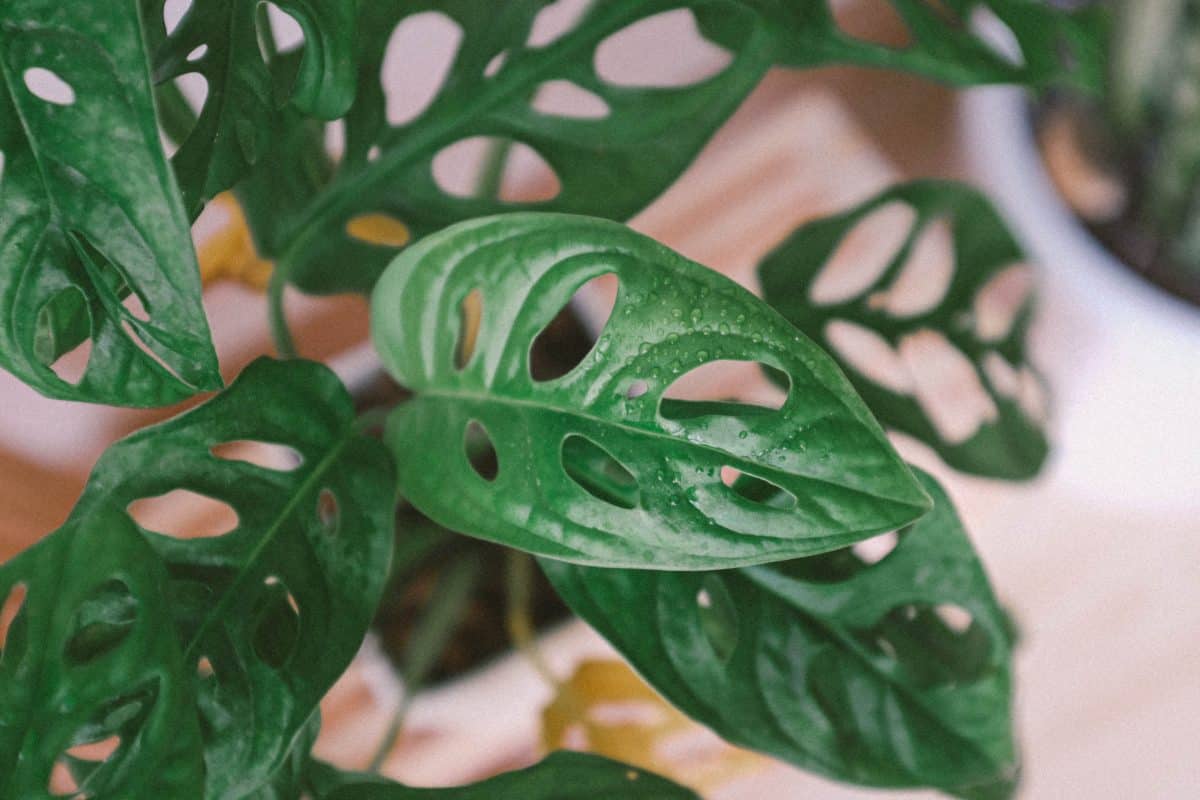The indoor houseplant world has fallen head over heels for the beautiful monstera plant and its large slotted leaves. But did you know there are several different monstera varieties with their own variations in size, colors, and hole configuration? It’s true! In fact, there are 48 species of monstera, but you’ll find only a few in your local nursery. We’ve included the most common ones here, along with a super rare one that’s only been spotted 17 times in the wild. Pretty neat, right?
Monsteras are often mislabeled in nurseries and garden stores because monstera leaves grow and change so much over their life span. A young plant might look completely different from its mature counterparts and actually look like a completely different species!
Here are the more common monstera varieties you’ll most likely find in your local nursery and for purchase online, along with some defining characteristics so you know what you’re buying!
Note: Split-leave philodendrons are often confused for monsteras (and vice versa), so make sure to read our post on how to tell the difference between the two!
Table of Contents
The Most Popular Monstera Varieties (and Which One Might Be Right For You)
Monstera Deliciosa
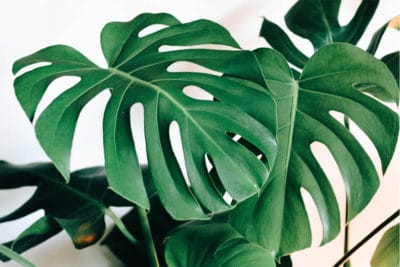
This is the most common variety of monstera we all know and love, and mostly what you’ll find when you go plant shopping. It has those big, gorgeous holey leaves that are so popular in nurseries and printed home decor right now. You can’t go wrong with this one! (Click here for The Ultimate Guide to Monstera Leaf Care.)
Fun fact: This plant is called “deliciosa” because this plant produces Mexican breadfruit.
Monstera Borsigniana
This is actually a variation of deliciosa and might sell under the same name because it’s hard to distinguish between the two when they’re young.
One way to tell is to look at the stem. Deliciosas tend to ruffle, pucker, or form cute little bumps where the leaf attaches to the stem, but borsigniana does not. Borsigniana is also smaller and grows faster than deliciosa. Mature plants usually form two neat rows of holes/slits instead of growing holes in a more willy-nilly style like deliciosa.
If you do end up with one of these instead of a deliciosa, never fear! It can grow just as tall, almost as big, and a bit faster, and it’s still a stunning addition to your home.
Monstera Variegata
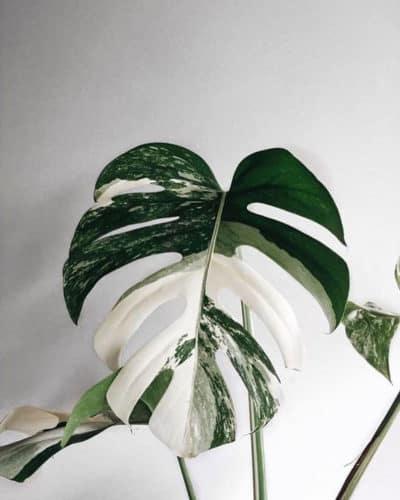
Variegated monsteras aren’t separate plants but rather a color variation. Sometimes these plants even look painted with white paint. I personally love them!
Variegated means plants that are patterned with white or cream color as well as green. These plants tend to be harder to find and are therefore much more expensive.
Many of the varieties on this list also come in a variegated form, by the way, if you’re lucky enough to find them! (Read our article Where to Find a Variegated Monstera for more info!)
Monstera Adansonii
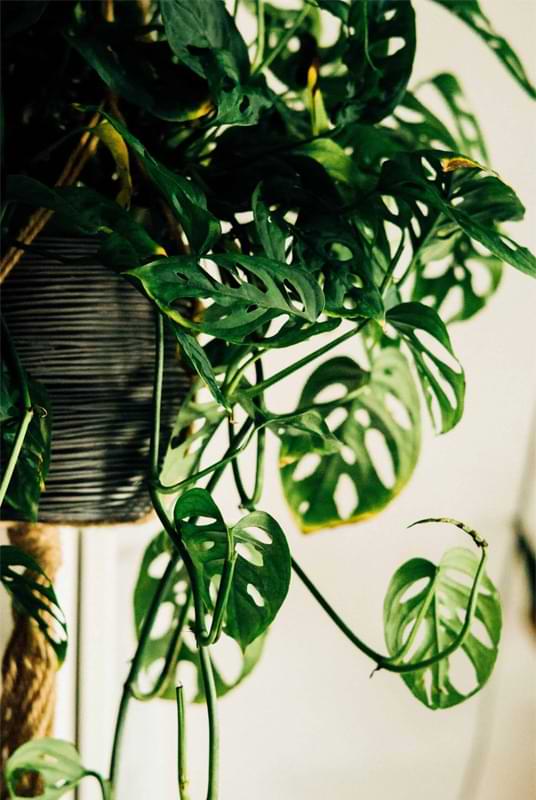
This variety is a bit smaller than the deliciosa, but the holes are still quite large! The holes tend to take up about 50% of the leaf.
These are fairly easy to find, but they’re also mislabeled as monstera obliqua (but true obliqua are extremely rare, so you can be assured that if you see this label in a nursery, you’re actually looking at a monstera adansonii). Adansonii also tend to have thicker, rougher leaves than obliqua.
Monstera Pinnatipartita
These guys have very large, glossy leaves, but tend to grow slits, rather than holes, that go to the edge of the leaf. The leaf stems are stiff and sturdy and they have a gorgeous emerald green color. These are a little harder to find, but you can usually source one or two online.
Monstera Dubia

This is one of my favorites! This variety is characterized by very small, heart-shaped leaves with both dark and light green coloration. It’s not variegated per se, but approaching it. It grows like a vine with shorter stems and leaves that grow closer to whatever the plant is climbing.
These are tricky to find, but if you do see one, snatch it up!
Monstera Siltepecana
This lovely variety has large, teardrop-shaped leaves with smaller holes concentrated around the central vein. They’re often lighter in color than other monsteras and contain both dark and light green hues. Gorgeous! They’re harder to find, but beautiful if you can get your hands on one.
Monstera Obliqua
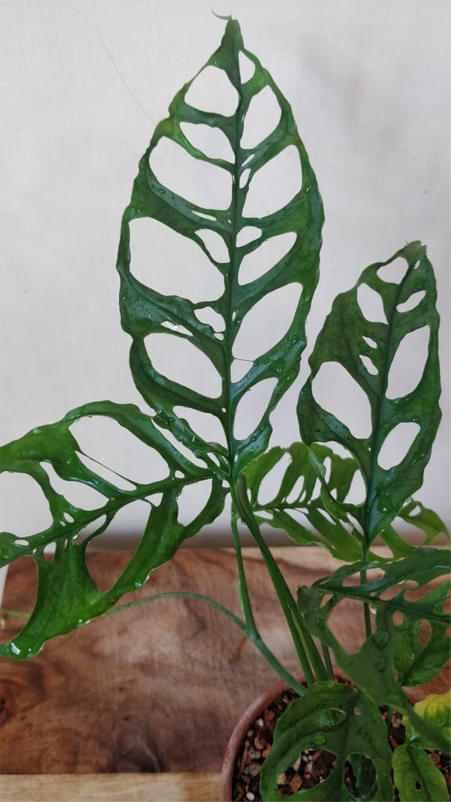
We hate to break it to you, but you won’t find this one at Home Depot, or anywhere, really. But it’s so neat that we still wanted to include it!
These stunning plants still have the characteristic holes, but the leaves tend to be more hole than leaf! The holes can take up to 90% of the paper-thin leaves, so these plants are extremely delicate and you won’t find them in nurseries. But if you’re lucky, you can catch them in some botanic gardens. This plant has only been spotted 17 times in the wild and is often studied for cross-breeding with other varieties.
Rhaphidophora Tetrasperma or “Mini Monstera”

We’re cheating here, because this plant isn’t technically a monstera (you probably noticed “monstera” wasn’t in the scientific name), but they look beautiful displayed with one!
This plant looks like a smaller version of monstera with the same characteristic holes in the leaves, though the large holes tend to reach all the way to the edge of the leaf and appear more notched. The deep green color is stunning, and these are more common than some of the more exotic monstera varieties and are still fairly easy to care for. (Read Mini Monstera Care Tips here.) Check this plant out on Amazon here!
Grow your collection!
The good news is, these varieties have very similar care needs, so you won’t have to re-learn how to take care of each new variety you add to your collection. Drop by your local nursery to see if you can spot any of these varieties, or conduct a search online. Some of the more exotic monsteras can be tricky to find, but it can be done! Your indoor garden will look amazing with a few of these.
To learn more:
- Sign up for our free Ultimate Monstera Webinar.
- Subscribe to our newsletter.
- Click to join our community on Facebook: Monstera Plant Resource Group.
- Read our Ultimate Monstera Watering Guide here.
- Be sure to grab your essentials here: Monstera Plant Food, 3-in-1 Moisture Meter, Premium Potting Soil, Houseplant Leaf Armor (which protects your houseplant from bacteria, fungus, and insects—and also cleans and adds shine to its leaves!)
- Looking to shop for plants online? Our trusted partners at Houseplantshop.com grow high-quality plants here in California and ship directly to you. Shop online now!


